A white crater has emerged from the flat soil of Camargue. A crater made of salt. There, along the sea, where the Rhône flows, there are salt marshes. On this side of Camargue, snow removal salt is produced. On the other side, on the side of the Petit Rhône, just outside the reserve, food salt is harvested. In the middle, in the delta, marshes and sansouires host a specific flora and fauna. Hikers and tourists stroll around and watch birds and flamingos going pink with the beginning of winter. White horses and black bulls graze between reed beds and rice fields and further north, above the immense Vaccarès pond, spread out large agricultural properties. Here and there, some big farmhouses and small villages. Whitewashed huts with reed roofs sometimes appear in the middle of the lagoons. Former “Guardians’ huts”, traces of a fading tradition. Small roads wind through a network of canals filled with water. And on the exteriors, on the edges of the Delta, what remains of a still alive french industry is buzzing with activity amidst wind turbines spinning in the wind.
What is Camargue? A natural reserve? A cultural identity? An agricultural and industrial space? A tourist place? A postcard landscape? All of this at once? Before coming here regularly during the two months of the end of this year 2019, I knew very little about Camargue. An old memory of the vast expanse of water of the Vaccarès pond, a can of coarse Camargue salt in my parents’ kitchen, a distant idea of traditions and emblems made of bulls, horses and flamingos. As I walk, on this end of the year, observing the landscape and the birds, I wonder about the history of Camargue, its evolution and its problems. And what it says about our relationship with nature.
All around me is water. Pure and salty. Sea, ponds, rivers, canals, marshes make up the landscape of Camargue. It is a wetland. An almost perfectly flat landscape, without relief. Seen from the ground, it is difficult to see the succession of water areas and the immense network of small canals delimiting a landscape shaped by human hands. Better seen from above. For centuries, human and agricultural settlement on the delta was limited by soil instability, freshwater floods in winter, drought and salinization of land in summer. The arrival of the 20th century marked the anthropization of the environment with the containment of the arms of the Rhône and the installation of an drainage network pumping fresh water from the Rhône to desalt the delta soils. Agriculture developed through viticulture and rice cultivation and the exploitation of salt was set up with the creation of the Compagnie des Salins du Midi. The development of the delta was accelerating through the construction of several industrial villages and railway lines. The exploitation of fresh water for agriculture and salt water for the salines however led to a mixture of water within the irrigation network and the central ponds of Camargue. Strong friction between farmers and salt workers appeared for the management of the water in these ponds. But the central area of the delta, beyond being just a simple resource to exploit, is above all a wetland of very high biodiversity. In 1927, the Camargue National Reserve was created, reserving this central part and forming a buffer space between freshwater and saltwater lands. To this is added in 1973 the creation of the Camargue Regional Natural Park covering the delta plain delimited to the east by the “Grand Rhône”, to the west by the “Petit Rhône”, to the south by the sea and to the north by the agglomeration of Arles. Bringing together agricultural land, salt marshes and protected natural areas, the park has been working since then to reconcile environment and development.
Traveling through Camargue today, it is hard to imagine what the delta looked like before human hands shaped the landscape. I drive on small quiet roads in a peaceful atmosphere of early winter. The rice fields of which there is not much left at this time of the year diffuse a slight melancholy in the air. The salt exploitation of Salin-de-Giraud is stopped, the salt harvest has already been done. There are not many people and I appreciate the calm of the place. Some black bulls and white horses are still grazing in the reserve. There are not many of them and I wonder if it is because it is winter or if their exploitation is decreasing. In the past, herds were guarded by those called “gardians” (guardians of a Camargue manade or a group of bulls or horses bred in semi-freedom and belonging to a manadier). Today, it is very rare to see one. Small white egrets dig the soil near them. They are used to perching on the backs of bulls and horses but not today. The breeding of bulls and horses and their related activities (bullfighting events, professions of “gardian” and “manadier”) were the cement of the creation of the Camargue identity.
“The cultural factor was forged by poets at the end of the 19th century. Following Mistral, who first staged the Camargue in his poem Mireille (1859), two other “félibres”, also inhabited by concern to preserve the Provençal language and culture, chose to settle in the delta, to write there, but also to erect bullfighting and equestrian activities as a ferment of local identity. Joseph d’Arbaud (1874-1950) became famous with ‘La bête du Vaccarès” published in 1926. The Marquis of Baroncelli-Javon (1869-1943), a manadier in the lower Camargue, became the emblematic figure of “camarguité” [Pelen 1987]. We owe him the invention and the definitive fixation of the Gardian tradition. Resistance of lake environments to human penetration symbolizes for these writers represent Provençal culture and language opposed to the supposed standardization of the French country. “Poets, scholars, gardians, fishermen and gypsies ”are mobilized, in the literal sense of the word, in “the Gardian nation”, which, codified in every detail, will quickly become an original cultural tradition. This movement will be expressed in military terms and, although opposing the big landowners, will consolidate Camargue insularity by adding to the “Camargue des Camarguais” a “Camargue, land of traditions.”1 Today, Camargue traditions are losing momentum in everyday life. There is not much left of the “gardians” and their traditional art. And the majority of animal husbandry and agriculture is done using machines. Camargue culture is now found only in the few museums of the region and in bullfighting events and summer celebrations that keep some heritage value and serve as a tourist attraction.
1. Bernard Picon. Chronicle of representations of nature in the Camargue. In: Rural Studies, n ° 141-142, 1996. Cultivating nature
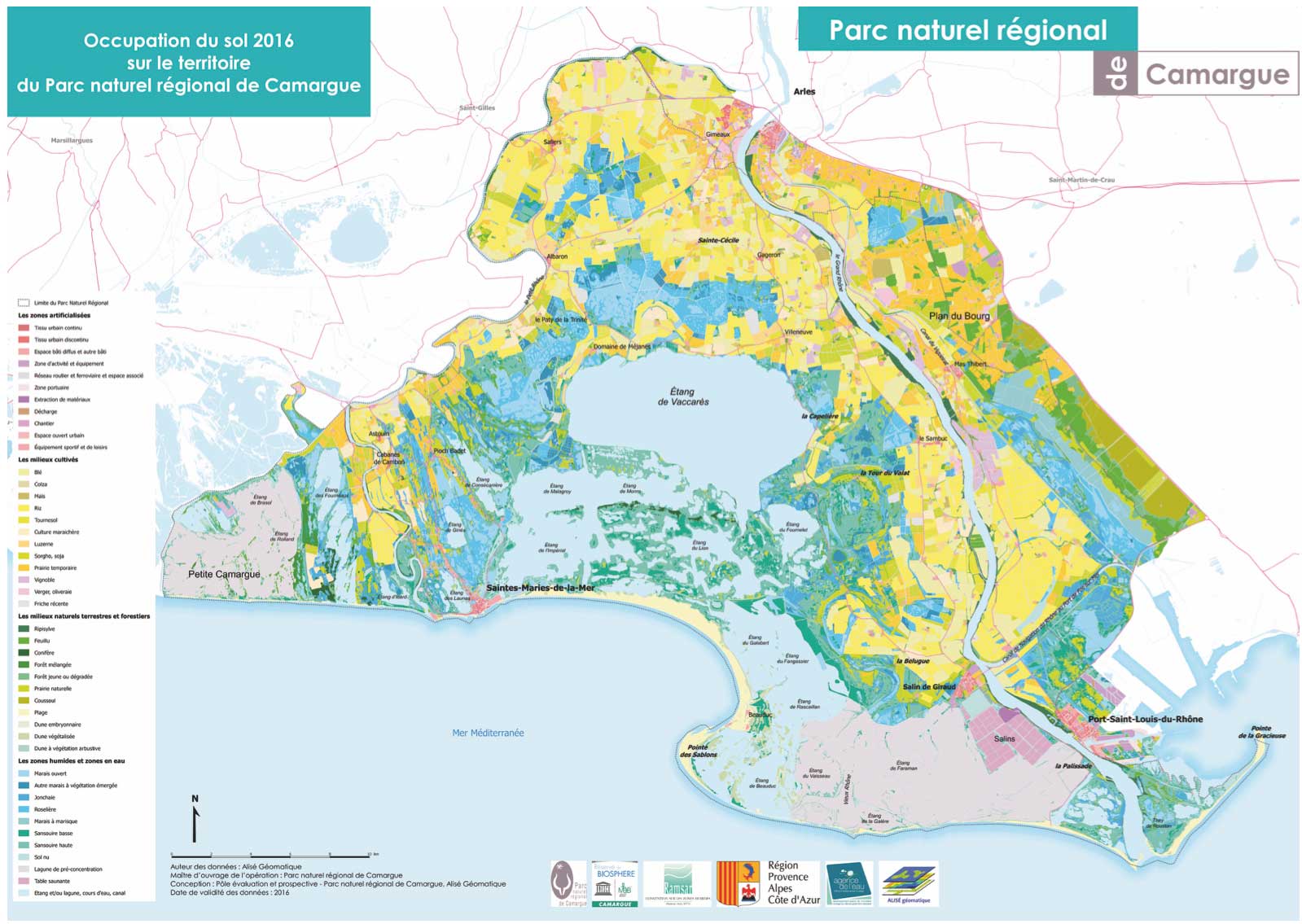
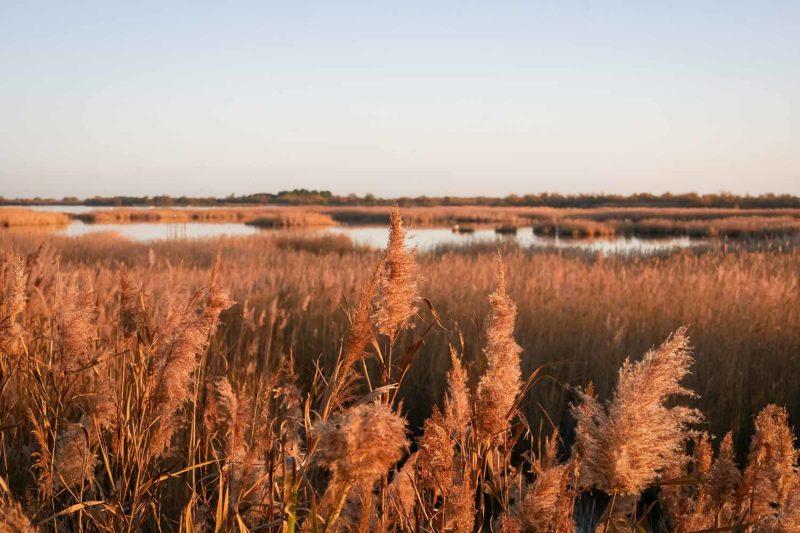
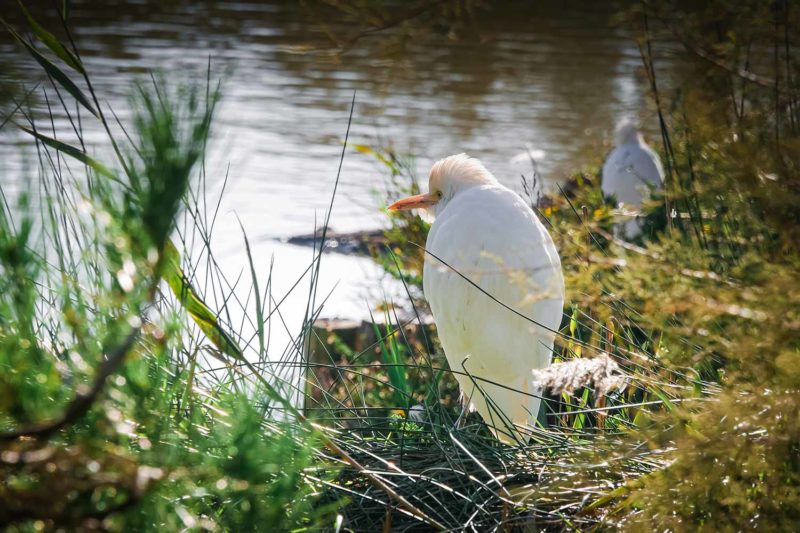
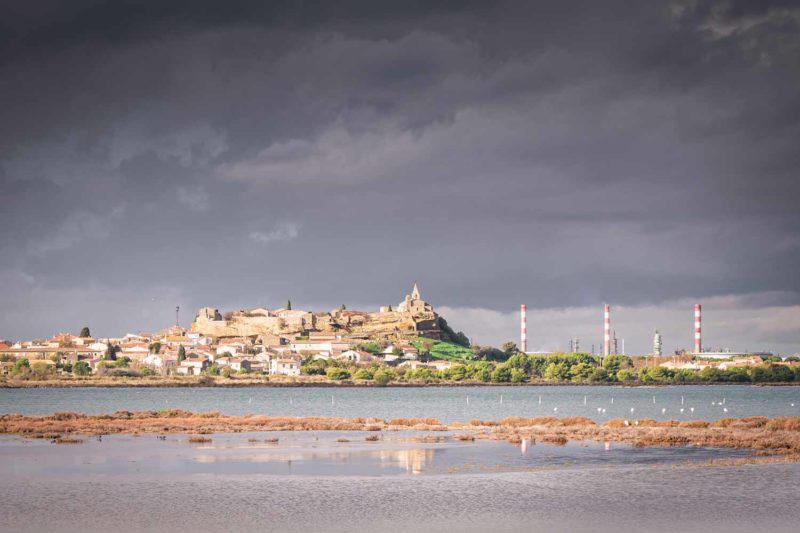
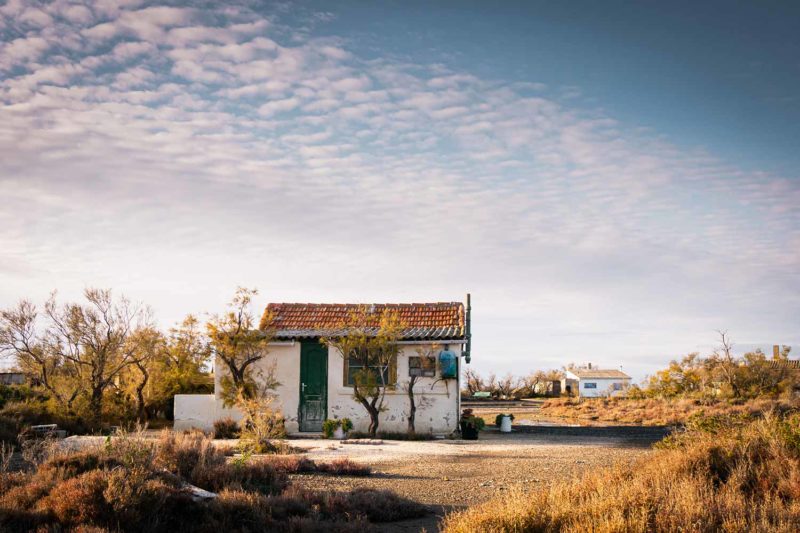
Between nature reserve and industrialization. Camargue mixes marshes, villages and old fisherman’s huts falling slowly into disuse.
A soft friction sound invade my ears. The wind has strengthened and reeds rustle under the gusts of wind. They are everywhere in Camargue. They grow along the multitude of small canals forming pretty reed beds called “roselière”. In the Middle Ages, reeds were harvested by hand. They were cut green in summer to be used as food for cattle and dry in winter to be used as thatch in the homes of “gardians”. These small huts generally built in the middle of marshes were entirely assembled by hand using reeds and branches of the surrounding environment. Towards the beginning of the 20th century, the huts solidified, walls were whitewashed and only the roof remained in reeds. These are the constructions that will form traditional Camargue architecture, of which there are just a few remaining today. Since the 1950s, reed exploitation has been mechanized and is carried out on dry reed from mid-November to mid-March. It is used for making thatched roofs, reed being a very good sound and thermal insulator and for making fences, windbreaks, hunting lookout. I hear a strange noise as I walk along a small canal filled with reeds. A nutria is swimming between the stems calling its congeners. Heaps of little birds weave their way among the branches and a motionless gray heron almost invisible among the reeds observes me passing by. The reed beds are great living and breeding environments for Camargue birdlife. It is also here, in Camargue, that we find the largest concentration of reed. Their exploitation (through hunting, fishing, agriculture, etc.) is beneficial for the conservation of the Camargue wetlands in the context of sustainable use. They help to maintain the environments, to renew them, to manage the water supply, etc. But it could have negative consequences for bird life if mechanized activities intensifies. In Camargue today, all traditional exploitation ways face the same question: how to reconcile sustainable development and conservation of the natural environment?
In this beginning of winter in Camargue, there are not many people. Some campervans stroll along the dikes leading to the Gacholle lighthouse and I mostly meet photography enthusiasts who come to watch birds. Tourism in Camargue developed at the end of the 19th century at the same time as the Provençal poets invented the Camargue culture and its traditions. The village of Saintes-Maries-de-la-Mer by the sea has also attracted visitors since the Middle Ages since it is there, according to Catholic tradition, that a group of disciples of Jesus fleeing Palestine including Marie-Madeleine and Marthe, ran aground on a boat. Apart from tourism linked to religious worship and traditions, the delta also attracts visitors from neighboring regions who enjoy solitude, hiking and bird watching. And the qualification of a Nature Reserve and the presence of emblematic species including Flamingos today attract tourists from around the world. Tourism in Camargue is seasonal, making the bulk of its turnover in summer. The rest of the year, the place is rather quiet. Theme walks on foot or by bike are organized and signposted by the Park management. I take a leisurely stroll along the marshes following the discovery route called “Flamingos and Salt Circuit”. The path takes me through the Fangassier pond, the nesting place of the Greater Flamingos of Camargue and around the exploitation of the salt marshes near the village of Salin-de-Giraud. Signs tell me that roads are closed to cars, that wild flowers should not be picked and that camping is not allowed. In the 1900s, the natural areas of the Camargue were mainly used by locals as a recreational area. With the development of “Camargue culture” in the 1980s, an influx of wealthy tourists appeared from major European cities. This was the start of mass tourism in Camargue and the implementation of the first restrictive measures aimed at regulating access for visitors. Access to cars and camping was prohibited on the coast in 1981 and the locals lost free access to the environment in which they lived.
In a survey carried out in 1984 in Camargue, Bernard Picon highlights that the people coming to visit the protected natural spaces with restrictive access are not the local people but people foreign to the region (either from other regions of France, or other countries). These people are generally from the middle and upper classes of society. “The middle or upper strata of society do not hesitate to travel hundreds of kilometers for a few days of contemplation of nature or to observe birds. Very few are those who say they came only to spend a few days of vacation without any other motivation. It is actually a relatively “selfish” practice of avoiding summer crowds. This practice can thus be added to a certain number of other symbols of social differentiation: making a distant trip out of season to immerse oneself in a natural environment seems to be one of the attributes of the middle-upper strata of European societies. This observation highlights the certain social ambiguity that constitutes a nature protection policy in specific areas. Local populations are prohibited from certain forms of habitual practice in the areas in question in the name of a rationality which is generally foreign to them. As we will see below, they have the feeling of being excluded from their own territory because access constraints favor leisure models that are not their own. Of course, this policy is not premeditated since the reasons behind the bans are reasons of biologists, botanists, geologists or ornithologists ”1.
This contradiction between nature protection, restriction of access, local population and tourism is a very interesting subject for me. There are many places in Camargue that were once accessible to everyone and that are no longer available today. As I wander among the marshes, I can’t help complaining about access restrictions and the fact that I can’t move freely. And yet I am someone totally in favor of environmental protection who fully understands the need to limit access in the face of the impact of mass tourism. How is it possible to reconcile nature protection, freedom of access and mass tourism? This is a question that occupies my mind a lot and which I have been confronted a lot during my five years of travel and especially during my stay in Iceland. The vast majority of the procedures put in place seem to focus on restricting free access and setting up guided tour offers. The problem with this solution for me is that it takes away the main attraction of a stay in the great outdoors: immersion in a wild natural environment away from the crowds. I think that the solution is not to limit access more and more, but rather to change mentalities, to change our relationship with nature. We should all be able to respect, protect and limit our impact on nature so that we can enjoy it freely. It may be a naive view of the problem, but I want to believe that one day the human population will be able to behave intelligently towards nature. Finding these same issues in Camargue makes me realize how the whole world is facing the same problems.
1. Bernard Picon. Conflicts of use on the Camargue coast: protection of nature and social practices. In: Norois, n ° 133-135, January-September 1987. Coastal areas and coastal societies
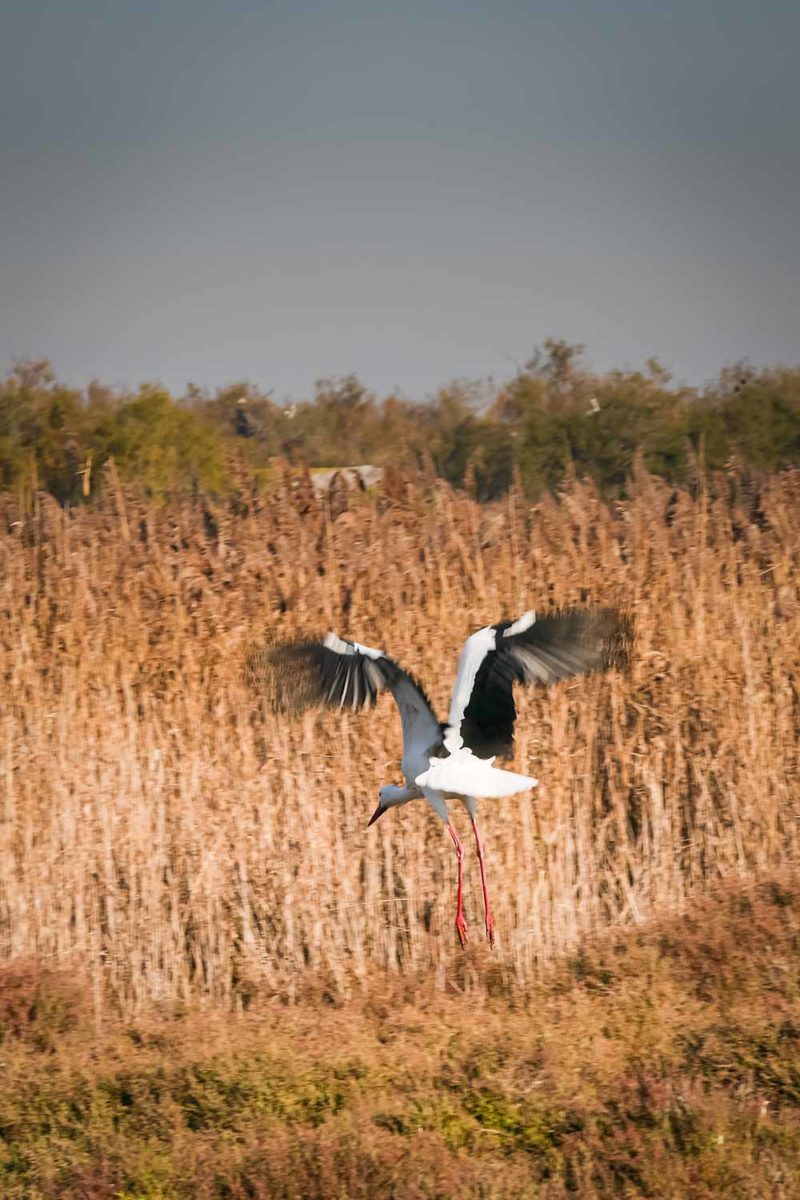
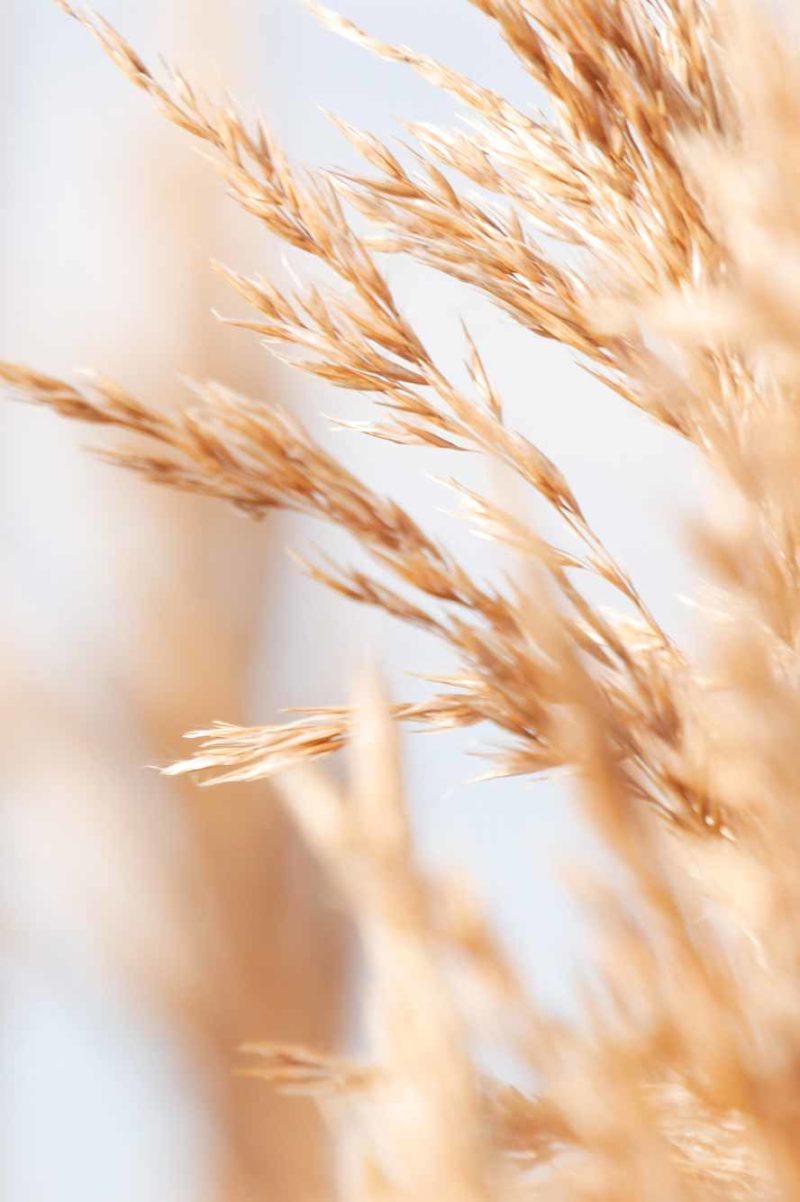

In the delta reeds are omnipresent. Among the vegetation many gray herons and some storks can be observed.
Water and environmental management in Camargue has always generated strong conflicts between the different users. Each of the points that I evoke after, concerning the field of water management, find themselves divided between the often incompatible needs of the various actors of the environment. The first point to be problematic concerns the quality of the water: salty for saliculture, fresh for agriculture, brackish for natural environments. Water pollution via pesticides and fertilizers are also problematic for the conservation of natural environments. The second point concerns the seasonality of the delta. If the management of water balanced between fresh and salt water allows the diversity of human activities in the delta, it reverses the natural cycle of the seasons since the water levels are high in summer (in order to allow rice growing and harvesting salt) and low in winter (which makes the protection of certain animal and plant species difficult). The third point concerns the desired height of water in an environment to allow the practice of an activity. Hunting, reed cutting, fishing, rice growing require different levels of water. In the same space, the Rhône delta, there are activities requiring different water needs. How to make these activities compatible?
Another example illustrating the difficult cohabitation between men and nature concerns the Greater Flamingos. Spring in Camargue rhymes with agriculture starting again and rice fields being sown. For the past twenty years, Flamingos have gotten into the habit of going to eat in the rice fields. Landing in a group of a hundred individuals, they wade in the fields, digging up the seeds in order to feed on them, inadvertently burying the rest and causing great damage and economic losses for the rice farmers. Following the trampling of birds, the plots must be re-sown. Between 0.5 to 5% of the total area of the plots are affected. To try to stop the birds, producers use scaring techniques (beacons, gas cannons, watchtower, etc.) which prove to be quite ineffective. The pressure of flamingos on rice fields is more important today because of the gradual increase of the flamingo population in the Camargue, the enlargement of rice plots and the disappearance of hedges. These last two factors being the consequence of the intensification of farming in the delta and the widespread use of the helicopter for the application of pesticides. In the face of the damage, some unhappy producers demand compensation. Others question the protected status of the bird, deeming its number too large and even wishing to regulate the population through hunting. An approach that goes in complete opposition with all the efforts of the Camargue Regional Natural Park to protect the vulnerable bird. Several agri-environmental measures have been put in place, including assistance in replacing hedges around the plots which have a proven deterrent effect on flamingos. However, these measures have not been followed largely by rice farmers, claiming an incompatibility with their intensive farming practices (aerial spraying of pesticides made difficult with the presence of hedges, irreconcilable irrigation scheme, presence of possible pests, etc.). This illustrates the evidence of the divide between the logic of industrial agriculture and the protection of nature that surrounds it. Fortunately, some farmers have agreed to set up a diversified polyculture system integrating the presence of hedges and the result is positive. The joint future of the Flamingo and agriculture in Camargue will have to go through a change of approach in farming practices.
In 2010, the Camargue Regional Natural Park implemented a new charter defining the directions to follow for the next twelve years with the aim of making Camargue a successful management model adaptable worldwide. The main values of the park are to preserve and enhance the natural and cultural heritage of Camargue and to support social, economic and territorial dynamics. The park seeks to reconcile protection of biodiversity and human and social development. The new Park charter revolves around three themes: water management, the establishment of a lasting relationship between man and nature and the desire to place the population at the heart of the development of the territory. Today, the climate change, the rise of sea level, the collapsing of the delta (due to the lack of sediment supply via the rivers now dammed), the contamination of aquatic environments by pesticides and the too high salt levels in the ponds poses serious problems for the future of the delta. These are the problems which the charter wishes to set up a concerned management and to raise awareness among the population. The new charter also highlights that despite the establishment of defenses against floods and rising sea levels, it will be impossible in the long term to maintain the protection of the entire coastline.
The restoration and protection of natural environments near agricultural areas and public domains cannot be implemented without the agreement and understanding of all the actors. The industries located at the edge of the delta, and in particular the Fos-sur-Mer industrial zone, cause particles to be emitted into the air, which impact on animal, plant and human species is being studied. Suppressing industrial activity (the little that remains) to protect the natural environment does not seem to me to be the way to follow, as the consequences for the french economy would be catastrophic. Responses putting in place a reduction in pollution and a desire to preserve the environment from industries in accordance with the Park charter seems to me to be a better solution. The Charter also seeks to develop what it calls “an eco-citizen conscience” through awareness-raising actions. The aim is to make the public and stakeholders understand how wetlands function and their protection. Environmentally friendly farming techniques are or will be implemented with the aim of promoting organic farming and sustainable agriculture. In order to maintain and enhance traditional techniques and know-how, the Charter develops promotion and quality initiatives through the award of labels and the “Parc” brand. The decrease in certain species (especially bird populations) due to the uncontrolled practice of hunting and fishing poses problem and the park is seeking to put in place regulations via a sustainable hunting plan and a fisheries management plan. On the tourism side, the Park wishes to develop exemplary sustainable tourism through an accompanied discovery of the territory, highlighting the Camargue culture and an offer of quality accommodation. The problem of the strong presence of the mosquito in the Camargue in summer, first source of discontent for locals and visitors, requires a search for a solution which should not be treated lightly. Mosquito control in Camargue would certainly make life easier for residents and visitors and could eliminate the possible presence of mosquito-borne diseases. However, the use of toxic methods or products could have harmful consequences for the local flora and fauna. The Park therefore seeks to set up treatments based on bio-insecticides and monitor their impact. In order to try to resolve the management and direction problems which often oppose inhabitants, farmers, industrialists and managers of the Park, the charter wishes to set up a system of “governance” representing all the actors of the environment. Numerous developments are planned, whether around the development of bicycle and foot transport, or trying to improve the quality of life for residents, the use of renewable energy or sustainable urbanization (energy efficiency, new modes architectural, bio-climatic designs, ecological materials, etc.).
Today at the end of 2019, while wandering around the park at the start of this winter, I think of the landscapes around me, its history and our relationship with nature. Natural environments around seem to be in good health. There are birds everywhere. I hardly see any waste on the ground. And even if activities seem to slow down, a feeling of simple joy seems to float in the air of Camargue. I was not in Camargue in 2012 and I don’t live right here. So it is a little difficult for me to realize the possible improvements implemented or problems that have arisen since the date of application of the new charter. Leafing through the general public and educational program for the Fall-Winter 2019-2020 period, I realize that many meetings and discovery activities are scheduled and that a new wing is added to the Museum of Camargue. Despite the calm of winter, Camargue seems very much alive and on a positive path. The challenges facing the future and the successful management of the various players in the same environment are a long-term work. I hope that Camargue, this land of multiples, this particular delta, will be able, if it is not already the case, to establish a positive and respectful relationship between man and nature.
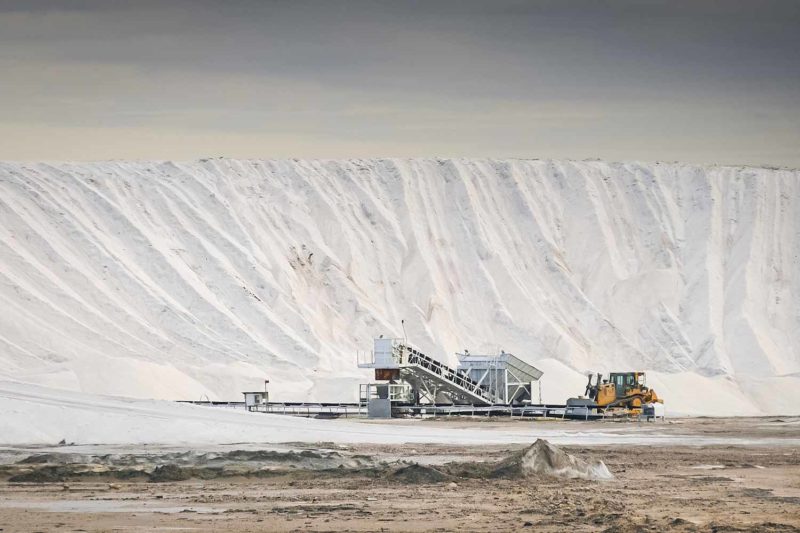
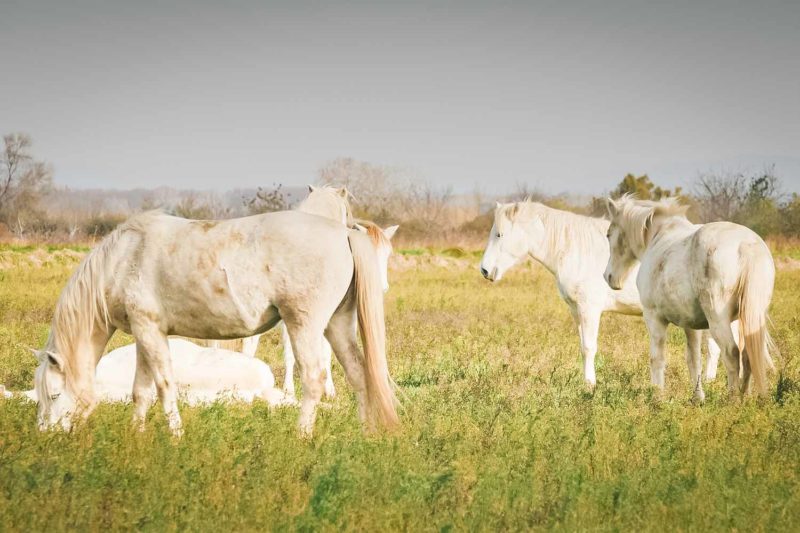
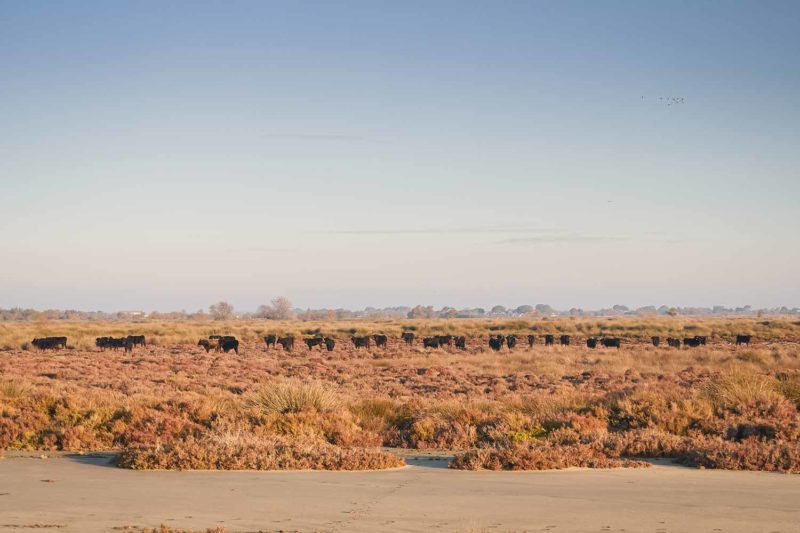

Some of the human activities of the delta: the exploitation of salt from Salin-de-Giraud, a herd of black bulls and small white horses, the heart of the gardian tradition, now endangered, and the industrial port of Fos-sur-Mer.
Bibliography – To go further (links in French):
- Camargue Regional Natural Park
- Camargue Charter – Main directions of the new territory project
- Objectives document about Natura 2000 sites “Camargue”
- The Camargue Biosphere Reserve
- Ineffectiveness of the Flamingo scaring in the rice fields of Camargue: when will agriculture be adapted to its environment?
- On the wise use of threats. A report on conceptions of nature in Camargue – Bernard Picon
- The Camargue : A Fragile Ecosystem and its Social Mechanisms of Transformation – Bernard Picon
- The conflicts of use on the Camargue coast: protection of the nature and social practices – Bernard Picon
- Agri-environmental measures relating to the exploitation of reed beds of the Rhône delta – Raphaël Mathevet
- The Petit-Rhône’s contribution to the irrigation and drying up of the Camargue and the Petite Camargue – J. Lonjon
- How will we transform the Camargue? – P. George et Camille Hugues
